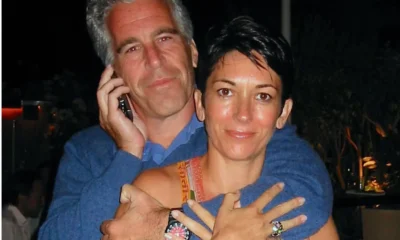Entertainment
The Craziest ‘Big Brother’ Twists of All Time: Secret Pairs and Beyond on August 1, 2023 at 11:20 pm Us Weekly

Although Big Brother follows a basic formula from year to year, fans know to expect the unexpected when it comes to production twists.
While some twists have jeopardized player’s games — see season 8’s “America’s Player,” Eric Stein — other houseguests have used the unforeseen circumstances to their advantage.
Jun Song, for example, pretended to hate her ex-boyfriend Jee Choe when he entered the house as part of the “X factor” twist during season 4. In actuality, the former couple had a secret side alliance for much of the competition and Jun went on to win the grand prize.
Keep scrolling to see the wildest twists in Big Brother history:
The Power of Veto
Once upon a time, the Power of Veto was not a core component of Big Brother, but a twist introduced during season 3 in 2002.
The twist — which allows the winner of the veto competition to save one nominee from the eviction block — has been used in every subsequent season and serves as a counter to the Head of Household’s power.
The Power of Veto gave season 5 houseguests Marvin Latimer and Nakomis Dedmon the ability to develop the Big Brother strategy known as the backdoor in 2004. That season, Jase Wirey became the first victim of the technique.
In a successful backdoor, the Head of Household nominates two pawns for eviction rather than their intended target. The HoH then arranges for the Power of Veto to be used on one of the pawns, thereby putting their target on the block without giving them a chance to compete for safety.
The X-Factor
Eight houseguests initially entered the Big Brother house during season 4 in 2003. The contestants were then told five more houseguests would be joining the competition, all of whom were ex-lovers of the original eight.
The twist quickly turned explosive, with Scott Weintraub going on a furniture-throwing tirade shortly after his ex-girlfriend Amanda Craig moved into the house. Weintraub was expelled from the game as a result of his actions.
The X-Factor twist returned in season 8 when Joe Barber discovered that his ex-boyfriend, Dustin Erikstrup, was also playing the game, and again in season 9 when exes Sharon Obermueller and Jacob Heald were paired up to compete as “soulmates.”
Project DNA
Bill Inoshita/CBS
Project DNA, comprised of Secret Siblings and the Twin Twist, was introduced during season 5.
For the Twin Twist, a pair of identical twins, Adria Klein and Natalie Carroll, both played as Adria, swapping places every few days unbeknownst to their fellow houseguests. The twins successfully made it to week five without the other contestants catching on, at which point they both entered the game as individuals. The twist returned during season 17 in 2015, when twins Liz Nolan and Julia Nolan placed second and sixth, respectively.
Project DNA, meanwhile, brought together estranged half-siblings Nakomis and Cowboy Ellis, who were unaware of each other’s existence before the show. Their connection was revealed during week two.
Summer of Secrets
During 2005’s season 6, each contestant had a secret partner in the game whom they knew prior to entering the house. The twist featured friends, couples, former coworkers, ex-roommates, neighborhoods and sorority sisters.
Initially, each secret pair thought they were the only duo with an outside connection. If both members of a twosome reached the final two, they received double the original prize money. The houseguests quickly figured out the twist and host Julie Chen Moonves confirmed it after the third live eviction.
America’s Player
CBS
The America’s Player twist was introduced during season 8 in 2007, with much of Eric’s game being controlled by viewers. At times, fan votes even influenced how Eric voted and who he targeted for eviction. While the twist was in many ways a disadvantage for Stein, he managed to finish in 5th place.
America’s Player returned during season 10 in 2008, with Dan Gheesling earning the title. However, unlike Eric, Dan was only America’s Player for one week, and he earned $20,000 for successfully passing all three of his missions, which included targeting Jessie Godderz and voting to evict him.
Coaches
Big Brother alums Dan, Mike “Boogie” Malin, Janelle Pierzina and Brittany Haynes all returned for season 14 in 2012 for the Coaches twist. Each of the four coached a group of new players and were told they’d win $100,000 if one of their players won the game. However, during week 3, the coaches were given an opportunity to play as individuals. Every coach except Mike took the offer, and all four coaches then entered the game.
During the season, Dan — who made it to the final two with season winner Ian Terry — executed one of the most iconic strategic moves in Big Brother history, known as Dan’s Funeral. After pretending to accept his own demise and making the house think he was on the outs with his No. 1 ally, Danielle Murphree, Dan convinced his former rival Frank Eudy to keep him in the game.
Battle of the Block
Introduced during season 16 in 2014, the Battle of the Block crowned two Head of Households each week for the first several weeks of the game. The HoHs each nominated two houseguests for eviction, and the nominated pairs then battled against each other to win safety and dethrone the HoH that nominated them. Frankie Grande notably won a BotB competition alone after his partner, Caleb Reynolds, learned he’d betrayed their alliance and refused to participate.
BotB, which returned during season 17, was controversial amid the Big Brother fan base, with some viewers feeling that the twist allowed for large alliances to maintain power from week to week, making for predictable and boring gameplay.
Split House
During season 24 in 2022, the cast was divided into a split house for the double eviction. The two groups played an entire week of the game completely cut off from each other, with five players inside the house at “BroChella” and five players in the backyard at “Dyre Fest.”
The twist led to Joseph Abdin’s demise as he was separated from several of his Leftovers alliance members. Leftovers member Kyle Capener used the Split House twist to out the alliance to his showmance partner, Alyssa Snider, and the Dyre Fest HoH, Terrance Higgins. The Dyre Fest group then targeted Joseph and he was evicted, which came as a shock to the other side of the house when the twist ended.
Although Big Brother follows a basic formula from year to year, fans know to expect the unexpected when it comes to production twists. While some twists have jeopardized player’s games — see season 8’s “America’s Player,” Eric Stein — other houseguests have used the unforeseen circumstances to their advantage. Jun Song, for example, pretended to hate
Us Weekly Read More
Entertainment
What We Can Learn Inside 50 Cent’s Explosive Diddy Documentary: 5 Reasons You Should Watch

50 Cent’s new Netflix docuseries about Sean “Diddy” Combs is more than a headline-grabbing exposé; it is a meticulous breakdown of how power, celebrity, and silence can collide in the entertainment industry.
Across its episodes, the series traces Diddy’s rise, the allegations that followed him for years, and the shocking footage and testimonies now forcing a wider cultural reckoning.

1. It Chronicles Diddy’s Rise and Fall – And How Power Warps Reality
The docuseries follows Combs from hitmaker and business icon to a figure facing serious criminal conviction and public disgrace, mapping out decades of influence, branding, and behind-the-scenes behavior. Watching that arc shows how money, fame, and industry relationships can shield someone from scrutiny and delay accountability, even as disturbing accusations accumulate.

2. Never-Before-Seen Footage Shows How Narratives Are Managed
Exclusive footage of Diddy in private settings and in the tense days around his legal troubles reveals how carefully celebrity narratives are shaped, even in crisis.
Viewers can learn to question polished statements and recognize that what looks spontaneous in public is often the result of strategy, damage control, and legal calculation.
3. Survivors’ Stories Highlight Patterns of Abuse and Silence
Interviews with alleged victims, former staff, and industry insiders describe patterns of control, fear, and emotional or physical harm that were long whispered about but rarely aired in this detail. Their stories underline how difficult it is to speak out against a powerful figure, teaching viewers why many survivors delay disclosure and why consistent patterns across multiple accounts matter.
4. 50 Cent’s Approach Shows Storytelling as a Tool for Accountability
As executive producer, 50 Cent uses his reputation and platform to push a project that leans into uncomfortable truths rather than protecting industry relationships. The series demonstrates how documentary storytelling can challenge established power structures, elevate marginalized voices, and pressure institutions to respond when traditional systems have failed.
5. The Cultural Backlash Reveals How Society Handles Celebrity Accountability
Reactions to the doc—ranging from people calling it necessary and brave to others dismissing it as a vendetta or smear campaign—expose how emotionally invested audiences can be in defending or condemning a famous figure. Watching that debate unfold helps viewers see how fandom, nostalgia, and bias influence who is believed, and why conversations about “cancel culture” often mask deeper questions about justice and who is considered too powerful to fall.
Entertainment
South Park’s Christmas Episode Delivers the Antichrist

A new Christmas-themed episode of South Park is scheduled to air with a central plot in which Satan is depicted as preparing for the birth of an Antichrist figure. The premise extends a season-long narrative arc that has involved Satan, Donald Trump, and apocalyptic rhetoric, positioning this holiday episode as a culmination of those storylines rather than a stand‑alone concept.
Episode premise and season context
According to published synopses and entertainment coverage, the episode frames the Antichrist as part of a fictional storyline that blends religious symbolism with commentary on politics, media, and cultural fear. This follows earlier Season 28 episodes that introduced ideas about Trump fathering an Antichrist child and tech billionaire Peter Thiel obsessing over prophecy and end‑times narratives. The Christmas setting is presented as a contrast to the darker themes, reflecting the series’ pattern of pairing holiday imagery with controversial subject matter.
Public and political reactions
Coverage notes that some figures connected to Donald Trump’s political orbit have criticized the season’s portrayal of Trump and his allies, describing the show as relying on shock tactics rather than substantive critique. Commentators highlight that these objections are directed more at the depiction of real political figures and the show’s tone than at the specific theology of the Antichrist storyline.
At the time of reporting, there have not been widely reported, detailed statements from major religious leaders focused solely on this Christmas episode, though religion-focused criticism of South Park in general has a long history.
Media and cultural commentary
Entertainment outlets such as The Hollywood Reporter, Entertainment Weekly, Forbes, Slate, and USA Today describe the Antichrist arc as part of South Park’s ongoing use of Trump-era and tech-world politics as material for satire.
Viewer guidance and content advisory
South Park is rated TV‑MA and is intended for adult audiences due to strong language, explicit themes, and frequent use of religious and political satire. Viewers who are sensitive to depictions of Satan, the Antichrist, or parodies involving real political figures may find this episode particularly objectionable, while others may view it as consistent with the show’s long‑running approach to controversial topics. As with previous episodes, individual responses are likely to vary widely, and the episode is best understood as part of an ongoing satirical series rather than a factual or theological statement.
Entertainment
Sydney Sweeney Finally Confronts the Plastic Surgery Rumors

Sydney Sweeney has decided she is finished watching strangers on the internet treat her face like a forensic project. After years of side‑by‑side screenshots, “then vs now” TikToks, and long comment threads wondering what work she has supposedly had done, the actor is now addressing the plastic surgery rumors directly—and using them to say something larger about how women are looked at in Hollywood and online.

Growing Up on Camera vs. “Before and After” Culture
Sweeney points out that people are often mistaking normal changes for procedures: she grew up on camera, her roles now come with big‑budget glam teams, and her body has shifted as she has trained, aged, and worked nonstop. Yet every new red‑carpet photo gets folded into a narrative that assumes surgeons, not time, are responsible. Rather than walking through a checklist of what is “real,” she emphasizes how bizarre it is that internet detectives comb through pores, noses, and jawlines as if they are owed an explanation for every contour of a woman’s face.
The Real Problem Isn’t Her Face
By speaking up, Sweeney is redirecting the conversation away from her features and toward the culture that obsesses over them.
She argues that the real issue isn’t whether an actress has had work done, but why audiences feel so entitled to dissect her body as public property in the first place.
For her, the constant speculation is less about curiosity and more about control—another way to tell women what they should look like and punish them when they do not fit. In calling out that dynamic, Sweeney isn’t just defending herself; she is forcing fans and followers to ask why tearing apart someone else’s appearance has become such a popular form of entertainment.

 Entertainment2 weeks ago
Entertainment2 weeks agoWicked Sequel Disappoints Fans: Audience Verdict on For Good

 News3 weeks ago
News3 weeks agoYolanda Adams Questions Traditional Views on God’s Gender, Audience Reacts

 Entertainment2 weeks ago
Entertainment2 weeks agoAriana & Cynthia Say They’re in a ‘Non‑Demi Curious, Semi‑Binary’ Relationship… WTF Does That Even Mean?

 News3 weeks ago
News3 weeks agoEpstein Files to Be Declassified After Trump Order

 News4 weeks ago
News4 weeks agoTrump Throws Epstein Files at Clinton’s Door

 Entertainment4 weeks ago
Entertainment4 weeks agoAriana Grande’s Red Carpet: When Fans Forget Boundaries

 Entertainment3 weeks ago
Entertainment3 weeks agoHollywood’s Kiss or Miss Policy: Why Saying No Got Neal McDonough Blackballed

 Entertainment3 weeks ago
Entertainment3 weeks agoJimmy Cliff, Reggae Legend and Star of ‘The Harder They Come,’ Dies at 81


























